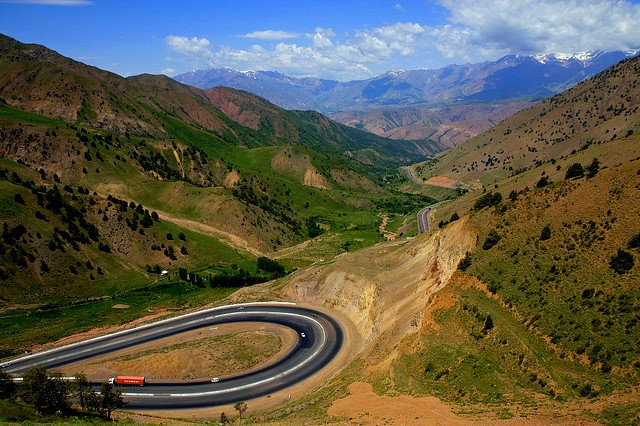For its picturesque scenery, Ferghana Valley is rightly called a pearl of Central Asia. The valley is mostly surrounded by the Tyan Shan, Hissar and Alay mountains, and only in the west, it is open for the Syrdarya River.
Today, Ferghana Valley is one of the prosperous regions of Uzbekistan. Fertile oases enclose the region. Along the northern boundary of the valley there flows the Syrdarya River, which is formed by the confluence of two smaller rivers, the Karadarya and the Naryn. Their waters feed three main canals: the Big Ferghana Canal, the Southern Ferghana Canal, and the Northern Ferghana Canal, the first nation-wide constructions of the 20th century. The big cities—Andijan, Ferghana, Kokand, and Namangan—are located in the oases of the valley. In the rural area, there prevails the cultivated landscape, vast cotton fields, green spots of gardens, melon and gourd plantations, and vineyards cut with lines of irrigation ditches. Rows of poplar trees and mulberry trees, plane trees, and elms run along the highways.

Margilan is one of the most ancient cities of Central Asia. It is known from historical sources that Alexander the Great raided the territory from Khodjent to Uzgen; on his way back, he crossed the town, which later was named Margilan. In the 10th century, Margilan was already the biggest city of Ferghana Oasis and was famous for its silk fabrics, which along the Great Silk Road were delivered by merchants to Egypt and Greece, Bagdad, Khorasan, and Kashgar. Today, Margilan is still the silk capital of Uzbekistan. It is here that the famous khan-atlas fabrics, known in the world as Ikat, woven and dyed manually in accordance with the ancient techniques, are manufactured.
In 1876, after Kokand khanate had been annexed to the Russian empire, in 7.5 miles from Margilan, a town was built called New Margilan, which became the center of Ferghana Region. The construction works in this new town were carried out with respect to the regular plan, which in its general outline has been preserved in our time. New Margilan, first renamed Skobelev and subsequently into Ferghana, was built in accordance with a radial-circular system, the center of which was the fort constructed on the highest hill to the south from the city. In general, the plan of Ferghana copied the plan of St. Petersburg.
50 kilometres from Ferghana is a small town called Rishtan. From the old days, the citizens of Rishtan were renowned for their ceramics. For over 800 years, from generation to generation, the craftsmen have imparted the secrets of producing ceramics from the local red clay and the glaze manufactured from the natural mineral dyes and ashes of the mountain herbs.
For a long time, Kokand was the main city of Ferghana Valley. The first written evidence about the town of Khavikand can be found in 10th century chronicles, where it was mentioned as a town located on the Great Silk Road and famous for its crafts. In 18th-19th centuries, it was the capital of powerful Kokand khanate, the state that dominated most of the territory of modern Uzbekistan and contiguous states. Kokand was a big religious center. In the years of its prosperity, there were 35 madrasahs and 100 mosques.
Namangan – the homeland of Uzbek poet Mashrab, stands apart. Not far from Namangan, there are the ruins of ancient town Aksikent. Archeological research proves that the town had the citadel and thick outer walls. The town possessed an advanced trade and handicraft industry. Aksikent was the capital of Ferghana Valley up to the 13th century. It was later destroyed by the Mongols, and in the 17th century, a strong earthquake finally demolished the town.

Andijan – the biggest historical and cultural center in Central Asia. Andijon had a significant role in economic and cultural relations of Bactria, Sogd, and Shosh with China. In the first century AD, the city was part of Kushan’s kingdom. Eighteen miles from the modern urban area is the site of the ancient settlement Erish, the capital of ancient Davan state, which was famous for its swift-footed stallions. It was from here that these fast horses were delivered as precious gifts to the court of Chinese emperors. In the 9th-10th centuries, Andijan became the domain of Samanid dynasty.
In the 15th century, it was ruled over by Bobur, the descendant of Amir Temur, a poet, the author of famous epic work Baburname, a military leader who conquered India and formed the dynasty of Great Mogols. Bobur wrote about the city: “There are seven cities in Ferghana Valley. Five of them are situated on the southern bank of the Seykhun River, while the other two stand on its northern bank. One of the southern cities is Andijan, just in the middle. This is the capital of Ferghana Valley. Bread is abundant there and the fruit is rich, while melons and grapes are the best.”

Ferghana valley, the vast prosperous oasis with the most fertile lands in Central Asia and the finest climate, is rightly called “Golden Valley.”


